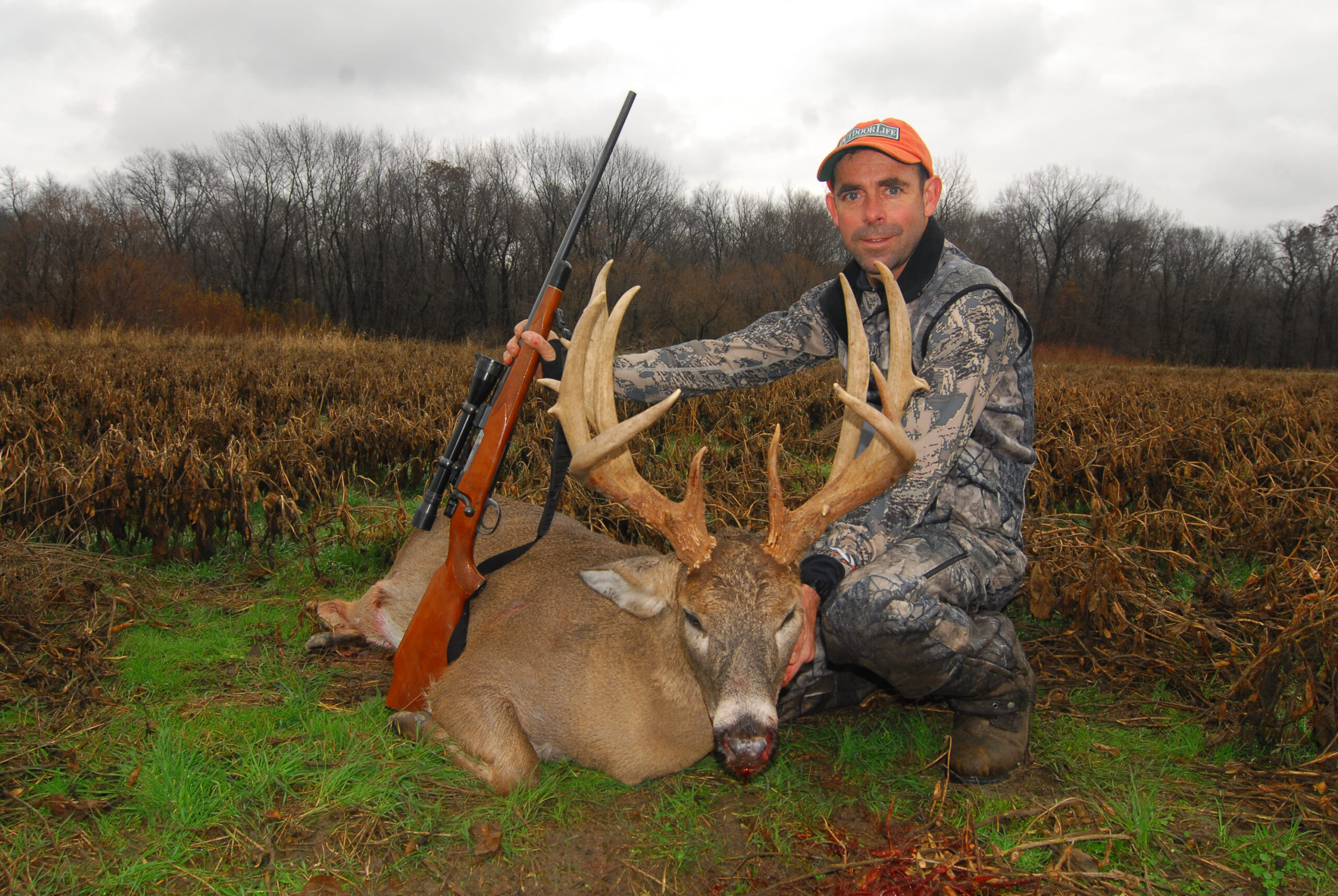UNLESS YOU CONSIDER the impenetrable 30 acres of head-high cattails in the old oxbow slough, the wildest part of this working alfalfa field is the stand of green ash and slag-bark cottonwood trees on its east side. I don’t go into this treeline much except to hunt for shed antlers or to push out the neighbor’s cows—or, every few years, to consider hanging a treestand. To call it woods is to exaggerate its size and density, but it’s always dark in there, cool, and slightly unsettling, a place you could imagine finding a human hand or the lid of an old chest.
I don’t often enter the trees, because their inhabitants come to me. That woodlot holds an astonishing number of whitetail deer, and most evenings in the fall, all I have to do is wait in the waving orchard grass way across the field to see what comes out. It’s almost always does and fawns—generally twins—first, and then younger bucks. At least in October and November, when I’m hunting the place regularly, the older bucks emerge last, like they’re waiting for an audience before they’ll make their appearance.
The rest of this field is so unwild that you can hear the switch and hiss of diesel engines on the Burlington Northern Santa Fe tracks across the Milk River, and when the wind is right in the summer you can hear the crack of a bat and the rising crowd at the Glasgow Reds baseball field. I’ve heard a jogger on the nature trail in the city’s Sullivan Park across the river call his dog by name.
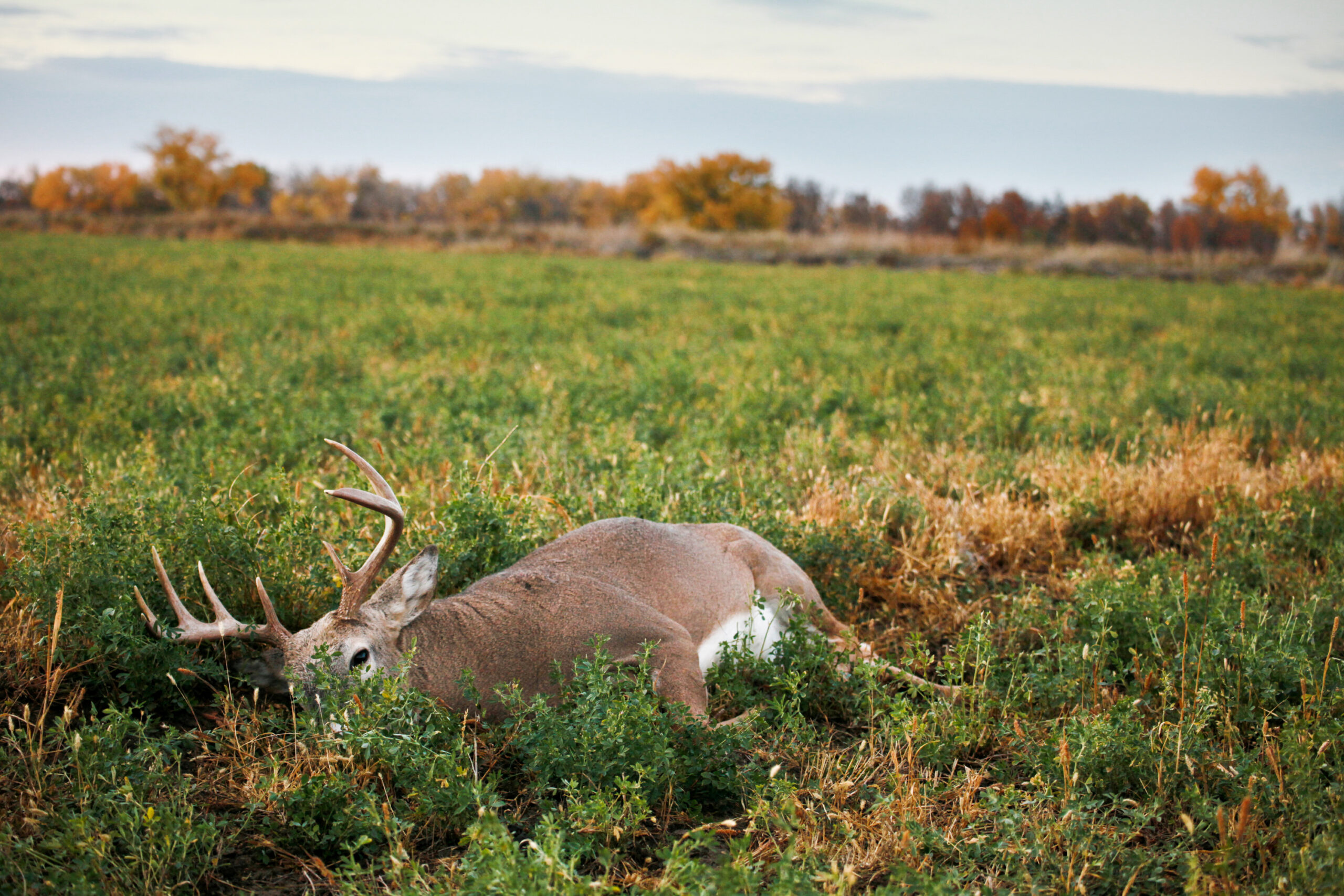
But this field, which gives up three cuttings of irrigated alfalfa in a good year, has an almost perfect arrangement of cover, feed, and water. It’s the wildlife equivalent of the Golden Ratio in mathematics, a place that’s almost supernaturally productive, holding deer when the rest of the country is barren, and pheasants when neighboring habitat is birdless.
Consequently, this field has raised my family on venison and roosters and has taught me most of what I have learned about twitchy Western whitetails. Along the way, it’s also taught me patience, persistence, and the perpetual possibility of this 140 acres of home.
In good pheasant years, I’ll kill a dozen limits out of the slough and grassy irrigation ditches. On bad years, I’ll learn something about my dog, or my shooting, or the innumerable ways old, wary roosters stay alive. In good whitetail years, killing a half-dozen does with my bow is a matter of staying quiet and still as deer file past my ambush spot on their way to feed on sweet alfalfa. “The dead-eyed march of the damned” is how I’ve described this single-minded procession to my kids, who have all taken their share of deer in this field.
Older bucks are altogether different. They are far more wary, far less forgiving of a shifting wind or careless movement. I’ve seen some truly giant whitetail bucks here, but I have killed only one that justifies the reputation of my Milk River as a trophy-buck destination.
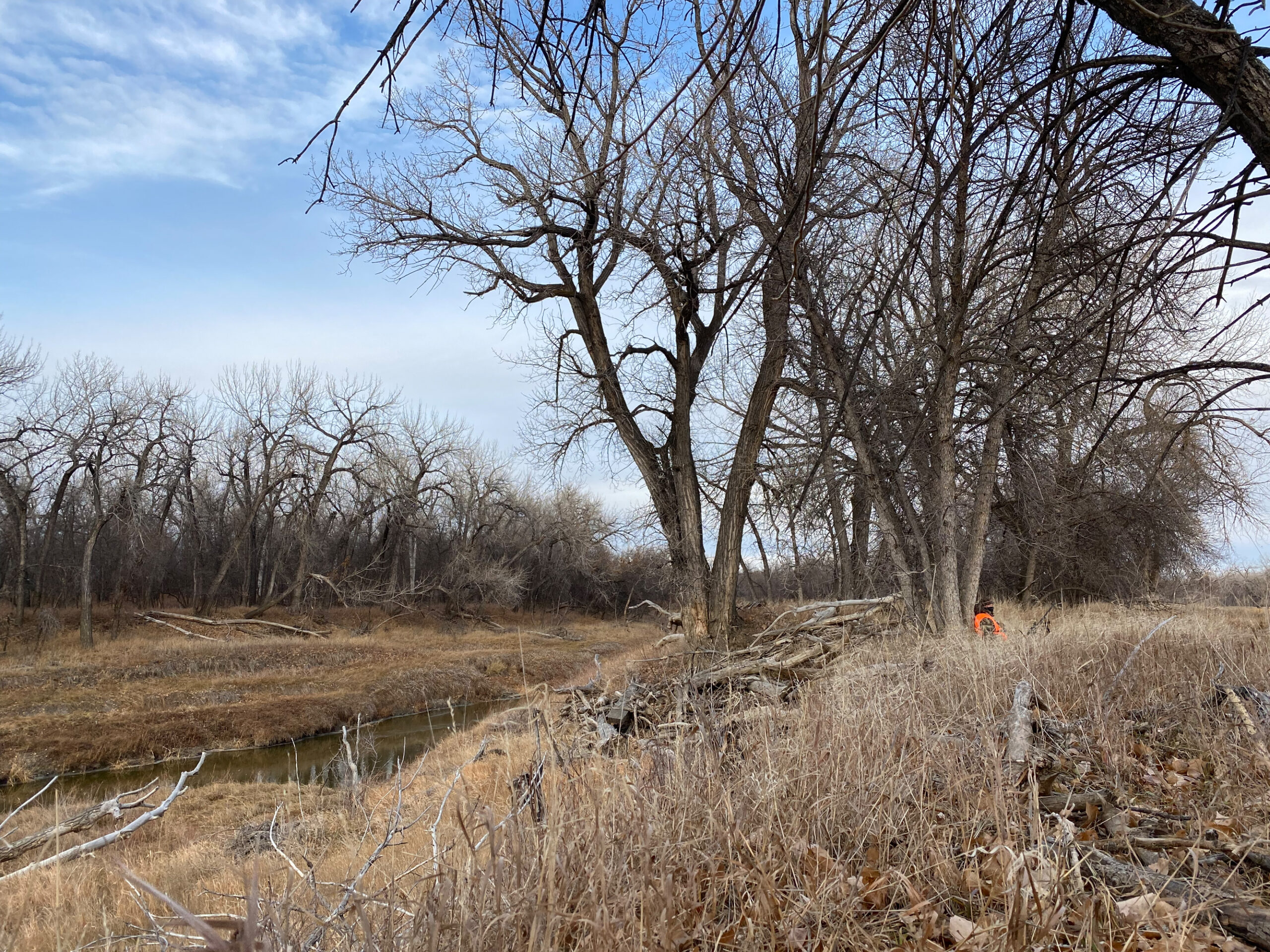
If it’s not wilderness, this place can be plenty wild. A cow moose has raised a calf in each of the last couple of years in the slough, and these aren’t the puny Shiras moose that occupy Montana’s mountains. These are Canada moose, originally from northern Saskatchewan and Manitoba, pushed south across the provincial grain belt by wolves or changing habitat. Dozens of long-legged moose now occupy the cattail swamps and willow bogs of the Milk River and its tributaries, so many that the state recently opened a hunting season for these immigrants.
I’ve followed mountain lion tracks along the frozen river, and a couple of years ago, the first legally harvested wolf in a full century was killed just a mile away from this field. Last year a rank Angus cow, unbranded, unclaimed, and unpredictable as a prairie fire, holed up in the slough. She’d emerge from cover to feed at night, and when she spotted me crossing the field during bow season, she’d bristle and huff and try to catch my scent. I took to walking to my pickup with an arrow nocked, and once under a feeble moon I was sure she was charging. The commotion turned out to be just a spooked deer, but for a few minutes that quarter section was as wild as any canebrake in Africa’s buffalo belt.
THIS GROUND keeps other secrets. It’s where I lost my gentle Lab, Willow, one December as she retrieved a rooster. She broke through the thin ice of the slough and was dead before I could find her, drowned trying to return to me under the ice. She’s buried under a lone ash tree on the edge of the field. It’s where I lost my dad’s pocketknife, a three-blade Case Stockman, while gutting a deer on a night so suddenly and brittlely cold that the cottonwood branches cracked and my bloody hands lost their ability to grip. It’s where I watched my 13-year-old boy stand frozen behind his rifle for over an hour as the cold and limb-sleep crept in and deer surrounded him before he could get a clean shot, showing more poise and grit than I’ve seen from most men.
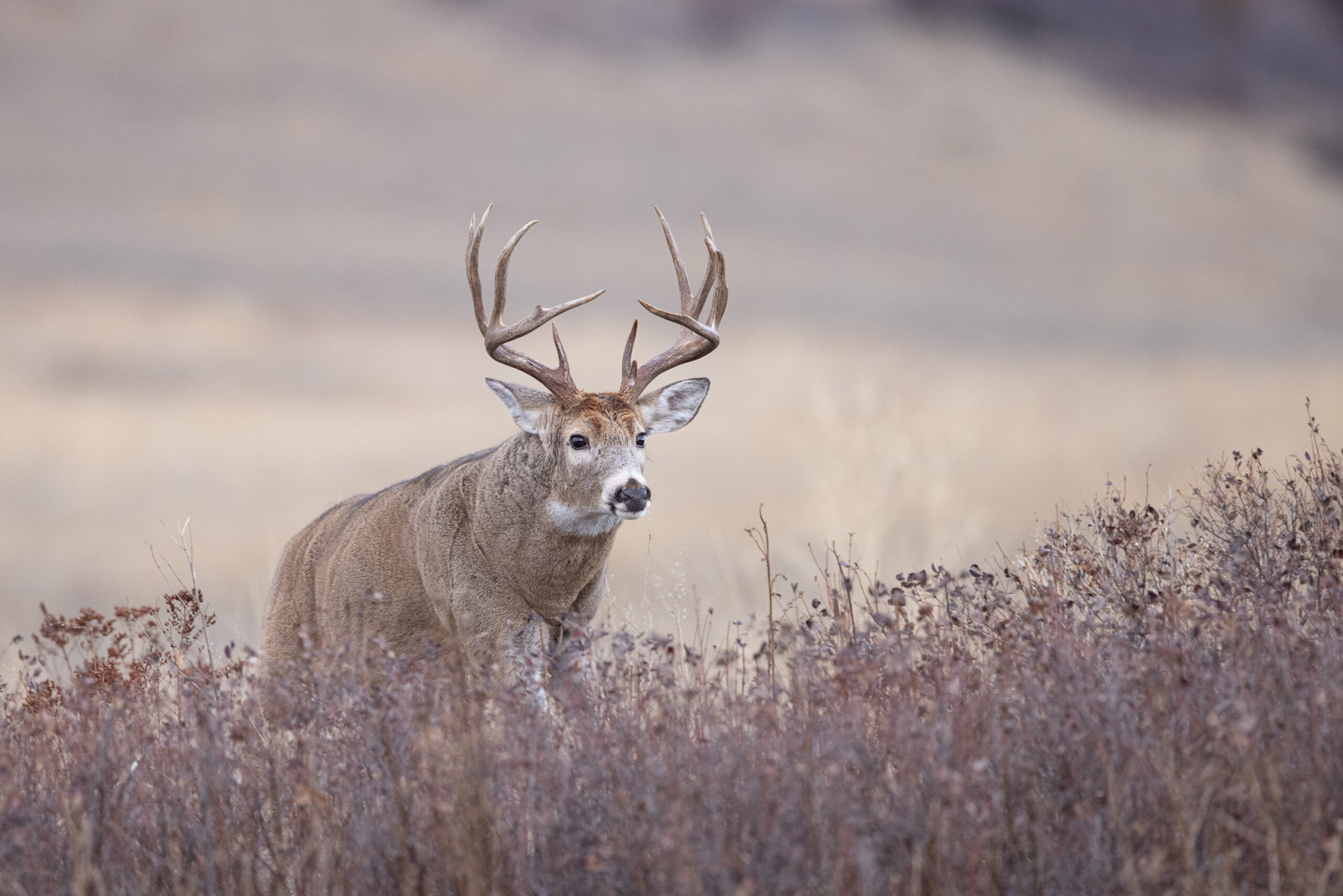
But one danger I don’t have to fret about here is falling from a treestand. I’m sure I’d kill more and better bucks from an elevated stand, and I tried it for a couple of years. But I’m not suited by nature to sitting still in a tree. I want the freedom to move, to make my own luck, and to get hit with the delaminating amphetamine rush that comes from being whisker-to-lips with a wide-eyed whitetail.
I climbed out of my last tree maybe 10 years ago, and I haven’t been inclined to return to their heights. Instead, I try to stay small and silent as I sometimes crawl, sometimes slither along the ground to get in range of deer. Happily, this place is made for hunters who are elevated by the thrill of kissing dirt and wearing mud and snow on their knees and elbows. We flood-irrigate our alfalfa, which means the fields are bordered by supply ditches, the intermediate step in delivering water that starts as snowmelt in the mountains of Glacier National Park before it’s shunted into the district ditch by a diversion structure maybe 20 miles upstream.
For a ground hunter, these dry field ditches are the master key to detection avoidance. Most are deep enough and bordered by a thatch of tall grass dense enough that a hunter can move unseen by doubling over. I’ve used ditches to walk (and often crawl) within bow range of dozens of whitetails, and as long as the wind is in my face and I move only when the deer have their heads buried in alfalfa, they are as surprised as I am when I finally square up for the shot.
I hardly have a monopoly on this style of hunting. Before treestands became popular, this was the way of all whitetail hunters, and it’s still a favorite method across the West. I’ve ground-hunted whitetails in Nebraska and Oregon and northeastern Washington and all around South Dakota’s Black Hills. Though the shots are longer and the cover thinner, hunting from the ground remains the best way to kill a trophy Coues deer in the Southwest.
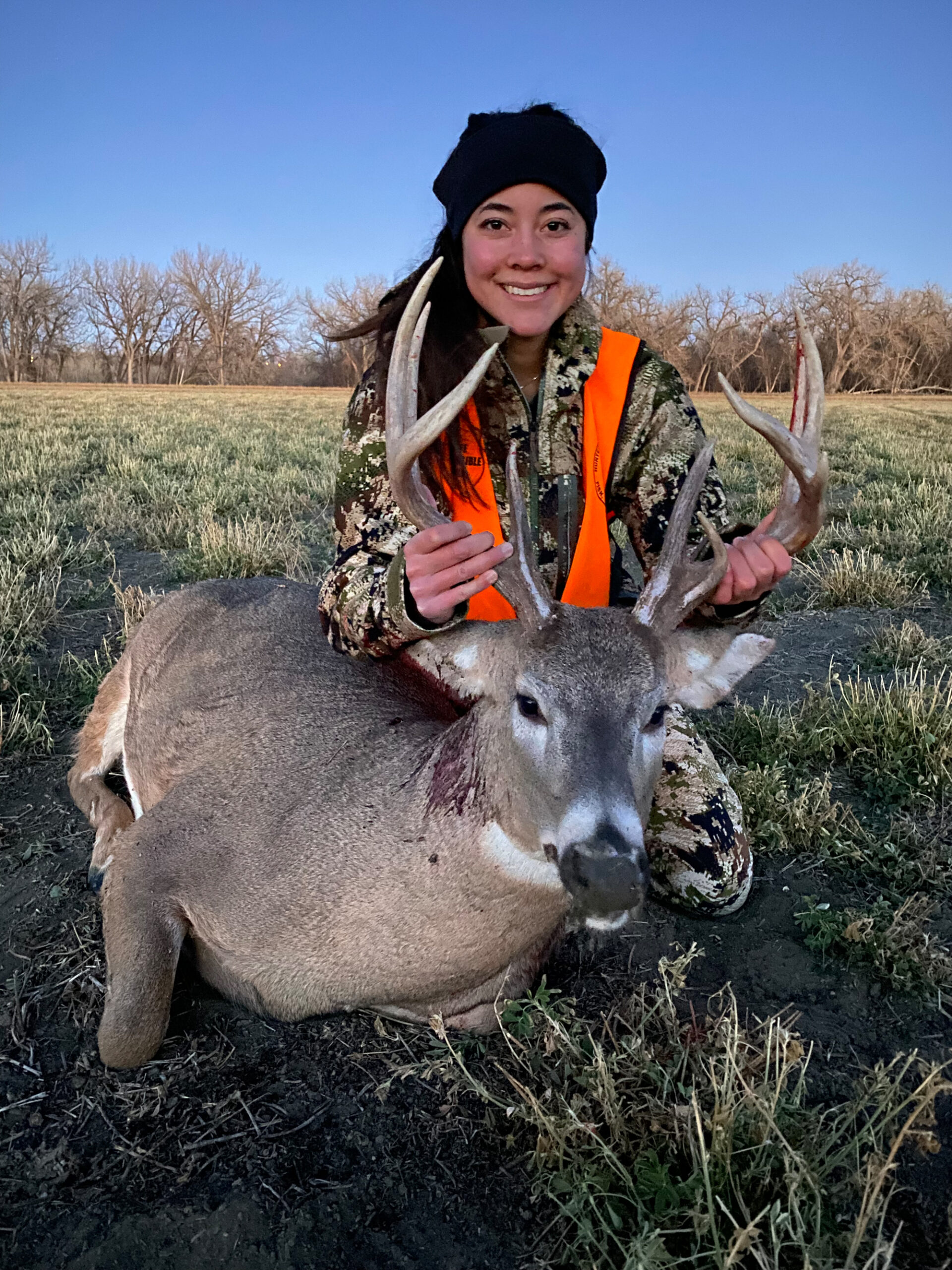
But moving across whitetail country is hazardous. One shift of the wind or one tipped-off doe can vacate the field in a flash. By far the better approach, at least in my particular case, is to get to the field on fall afternoons, before deer have emerged from cover and when the wind is blowing from Sullivan Park. I tuck into my favorite cover, a four-trunk ash tree exactly 326 yards from the eastern treeline, its limbs creating an obscuring canopy and the crisp brome grass smelling like straw. Hidden deep in the grass, with my pack for a pillow, I’ll sometimes watch migrating sandhill cranes or Canada geese arrow south under the high clouds. The first does and fawns that step out of the timber always take me by surprise.
In cycles of high deer populations, as many as 50 does and fawns and young bucks might feed out of the timber into the frost-sweetened alfalfa, followed by the older bucks. But it isn’t always this productive. About every 10 years, the Milk River valley is hit by EHD, a midge-borne disease that causes internal hemorrhaging and bleeding and kills whitetails indiscriminately. Back in 2014, we lost over 90 percent of our deer, and this field looked like a Civil War battlefield, holding dozens of bloated carcasses of bucks and does. Like my neighbors up and down the valley, I dragged deer into the river, and in a few places, dozens of decaying whitetails piled up like log rafts. My buddies said catfishing in the river was really good for the next few seasons.
IN YEARS of abundance, it’s customary for landowners to curse the numbers of forage-eating deer, and I’ll admit that they lose their specialness when the field is covered in a hundred whitetails. In those years, I fill all my available doe tags and invite my friends to come hunt, and we spend more time butchering deer than we do killing them. One year, I set up ground blinds for younger hunters, but my kids and I always hunted free, our term for using cover and wind to hunt from the open ground.
I came to this hunting style naturally. I grew up in the crucible of whitetail country, the rolling hills and hardwoods of northern Missouri, though when I started hunting, deer were scarce. I recall the first treestand I ever saw. It was a byzantine contraption of cable and chains that my dad found hanging in a hickory tree just inside our fenceline. He cut down the tree and displayed the mangled stand as a sort of trophy outside our sheet-metal machine shed, maybe daring the owner to come claim it.
Instead of perching, my dad employed what I now know as still-hunting, though his strategy consisted of equal parts pushing and posting. When I came of age, he’d leave me at an old wooden gate along a game trail that led from the hardwoods to the corn and soybean fields in the creekbottom. Then he’d slowly walk the woods, and it’s a testament to both his stealth and my obliviousness that he killed all the deer in our first years hunting together.
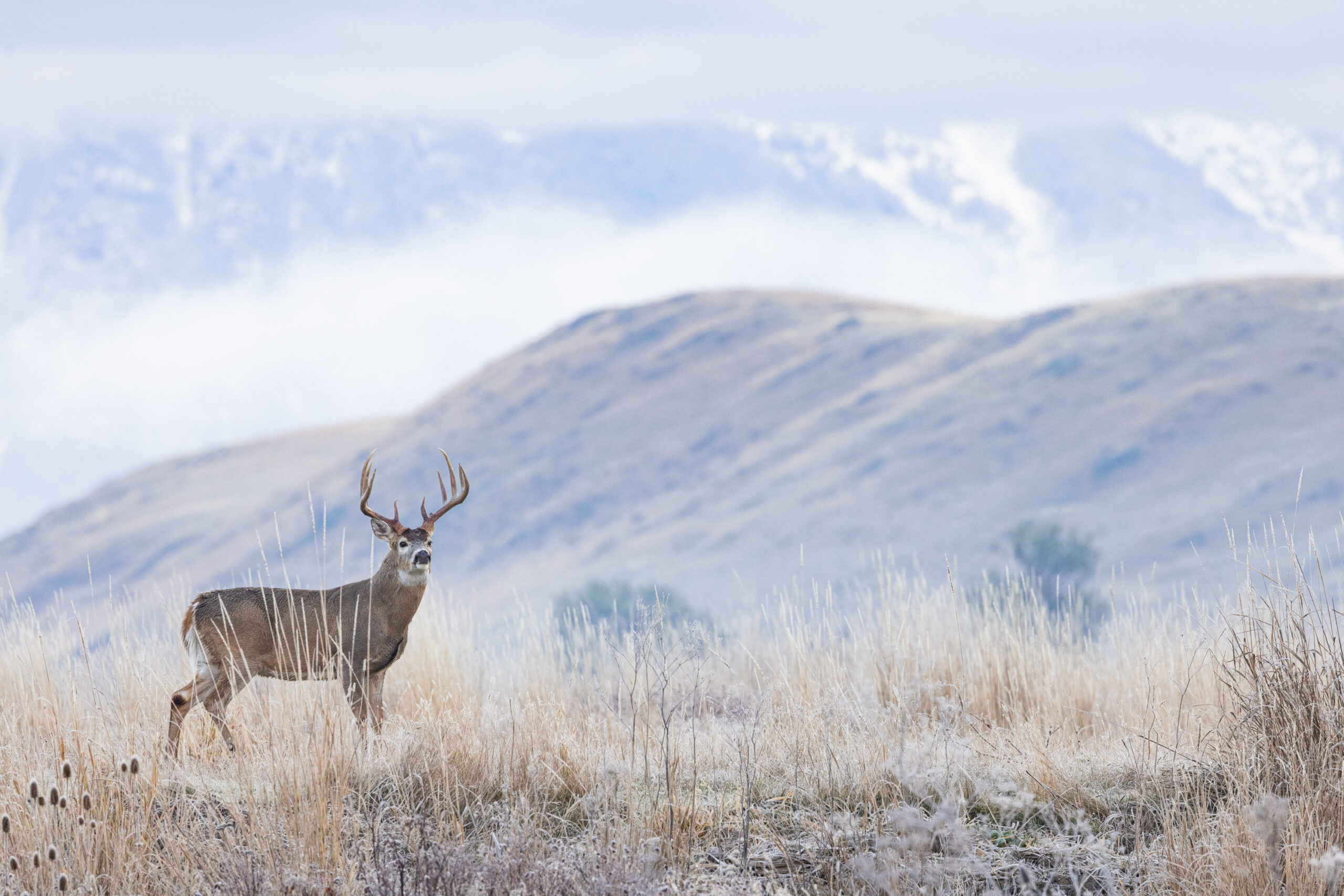
When I started hunting alone, I discovered a talent for moving quietly. I think it was just an extension of my personality; I was shy and squirmed under notice, whether it was that of a teacher or a stranger.
But in the woods alone, I could follow any cue that interested me. I’d test myself to walk quietly on leaf-covered cow trails or follow a single coyote track in the snow. Sometimes my journeys would take me miles and across other people’s land, but they led me to discovery: the remnants of an ancient cabin, the first wild turkeys in my county, arrowheads, morels, and cottonmouths. While my buddies learned the deadly advantages of treestands, I found the rusted action of an old percussion pistol in the crotch of a shattered elm.
That desire for exploration and discovery must be an inherited trait. My daughter, in particular, has a knack for staying small and deadly. Last year, while I was away hunting elk, she sneaked into our Milk River field and set up just inside a line of reed canary grass, her rifle on a bipod facing the woodlot. She waited as does and their fawns filed past, and then killed the first buck—a heavy 4×6—that gave her a good shot. It was the first deer she killed by herself, with no coaching or second-guessing from her father. When she said later that there had been bigger bucks out of range, I shifted my focus from elk and mule deer to back-field whitetails, and for three weeks I watched a tall-tined 5×5 every night.
Most evenings, he’d be the last deer out of the woods, swaggering into the fading light like a building contractor at Home Depot, but I could never get a close or clean shot. So I started setting up nearer the treeline, finally making a nest in a stand of leafless red willows. When the wind blew, the pool-cue saplings rattled and raked, opening and closing my shooting lanes with the spastic unpredictability of a flickering lightbulb. Then the rut started, and the big buck came out of cover. Early in the evening, I had a few opportunities for shots. But I confess to waiting longer than necessary in the hope that an even bigger buck might follow a hot doe into the field.
In Montana, we get only one buck tag, but we can apply for multiple mule deer and whitetail doe tags. This year I was determined to fill all those deer tags with my recurve. That lasted for about a week and the first whitetail doe. I switched to my compound when I saw two bucks that interested me, one a tall-racked 4×4 and the other a heavy 4×5.
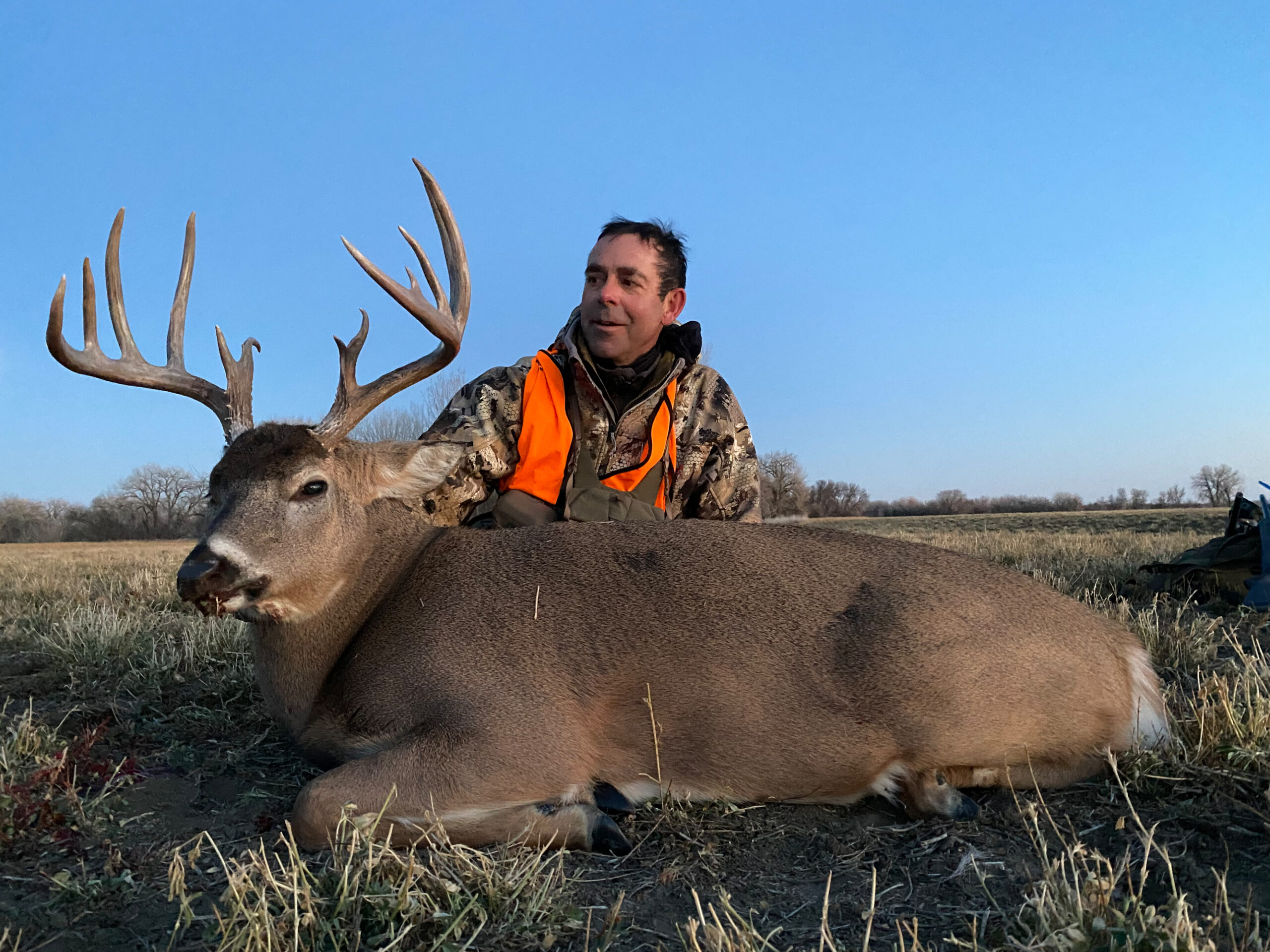
On the last Friday of the archery season, as a huge October moon rose over the Milk and I heard the cannon announce another home-team touchdown at the football field, I stood in tall grass and buckbrush just below the bank of the lazy river. My scent would spoil part of the field, but as long as it blew into the river, deer exiting the treeline shouldn’t smell or see me.
One of the chronic problems with ground hunting is the unpredictability of deer, and on this evening, the dozen does and fawns that fed past didn’t keep going. Instead, they stalled all around me, and as I focused hard on the two bucks 200 yards away at the edge of the trees, I heard a faint, unfamiliar sound on my downwind side. At first I dismissed it as the sound of a distant two-stroke motor, or maybe a railroader pounding a tie spike. Then I realized it was coming from much closer, and as I slowly, cautiously swiveled my head, I saw all dozen deer standing over me, two does slowly tapping their front hooves in apprehension.
Any deer hunter knows what followed. The little knot of deer blew up, noses snorting and tails flagging as they ran across the open field straight to the two bucks. What happened next was as unexpected as it was unnerving. Instead of fleeing the field, the two bucks shook their heads and marched straight for me, as though telling the does that they’d figure out what danger was hiding in the grass. I had just enough time to range a spot on the path I thought they’d take—42 yards—and then clip my release into my bowstring. The bucks were walking with purpose right for me. When they passed behind a screen of willows, I drew and waited for the first to come broadside into my shooting lane. My arrow arced straight for him, and then directly over his back. When I later ranged the spot, he was at 36 yards.
The bucks loped into the middle of the field, and we watched each other as the moon rose and brightened. Across the river, the Glasgow Scotties scored another touchdown.
Read more OL+ stories.
